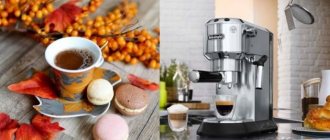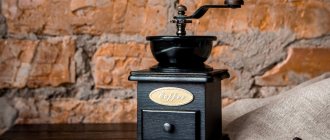True coffee gourmets do not follow progress, and will always prefer to choose a manual coffee grinder instead of an electric one. In addition to the stylish retro design, the advantages of mechanical models include high grinding quality, low noise levels and operational reliability.
Thanks to the millstones, the grains are ground into a homogeneous powder, without overheating or burning, as often happens in electrical devices. The rating presents the best models of manual coffee grinders for the home, which, according to true coffee connoisseurs, have a number of undeniable advantages.
Tips for choosing a manual coffee grinder
How to choose a manual coffee grinder? This is a rather complex issue that requires consideration of a huge number of factors that influence not only the appearance of the device, but also its functionality. Sometimes people choose a mill more for decorative purposes, others pay attention to its effectiveness. A good coffee grinder is part of the ritual of preparing a drink, so you should not neglect the importance of choosing one. If you are not ready to spend 5 minutes every day grinding beans, you should refuse such a purchase and choose an automatic analogue.
A mechanical mill cannot be very cheap, because ease of use is the most important factor. The handle should not dangle, rotation should be smooth, without hesitation or obstacles. If this is a desktop model, you need to consider its stability. Even such a detail as broken coffee beans can ruin the process of preparing your favorite drink. They are formed when the millstones are not fixed, sometimes “bouncing”, missing large pieces. You can't help but think about design. Fortunately, the kitchen market has a wide variety of similar devices at different prices.
Operating principle and design of coffee grinders
1. The electric coffee grinder consists of two compartments, with a filling bowl at the top and a motor at the bottom. After the grains are placed in the container, the lid is closed and the device is turned on. The grains are ground until the desired degree of grinding is achieved. Such devices are most often used at home. They do not provide the required uniformity.
2. Burr coffee grinders are similar to classic hand grinders, only they are powered by a motor. The product also consists of two parts: one for filling the grains, and the other for the finished product. Grains from one compartment to another are directed through millstones, which can be conical or plane-parallel. Conical ones consist of two cones inserted into each other, where only the lower one rotates.
3. Manual coffee grinders are almost identical to millstones, but all the work of grinding occurs due to the effort exerted by a person. The upper compartment has a rotating handle, which starts the grinding process of roasted coffee beans.
Type of shell
In stores or on online displays, you can easily get confused in choosing coffee grinders due to the huge number of offers. But there is one quality that can be determined immediately - appearance. Agree, no matter how convenient the device is, if its design does not suit you, using it will not bring pleasure.
According to the type of body, manual mechanical coffee grinders come in several types:
- eastern;
- European.
Eastern ones are characterized by a cylindrical shape, which is convenient to hold in the hand when rotating the lever. But they have a small drawback - low stability on a flat surface. This is especially noticeable when using a mechanical coffee grinder to make Turkish coffee. Its peculiarity is that it is ultra-finely ground, which is why the drink can be brewed in a Turk, and the grounds quickly settle to the bottom and do not interfere with enjoying the rich taste.
With this mill setup, the millstones are as close to each other as possible, requiring a fairly large force to be applied to operate the mechanism. European models are more sustainable. For better fixation, their body was slightly expanded, although the structure of the mechanism did not undergo changes. Ease of use is slightly better due to this small modification.
Housing material
The first manual mechanical coffee grinders appeared in the 15th century in the East. Previously, the grains were brewed whole, which did not allow the flavor and aroma to be fully released. Next, a method was invented for grinding coffee in a mortar. The process was long and labor-intensive, because everyone knows that the beans after roasting are quite dense. The advent of coffee grinders created a real sensation in the industry of preparing an invigorating drink. The body of the first mills was made of metal, and now they have become classic.
Various materials are used for this type:
- copper;
- steel;
- bronze;
- brass;
- aluminum.
But today they have lost their popularity, and the metal case has become more of a decorative piece of furniture. It's all about the influence of essential oils on the material. This problem is especially noticeable when using a cheap steel coffee grinder. The metal oxidizes quickly, which can cause coffee to have an unpleasant iron taste. Anyone who has tried a drink made from beans crushed in the Soviet Mechta mill understands this very well. The taste is very different, even compared to grinding on electric models.
Coffee grinders can now be found made of plastic. But when choosing a suitable model from this material, you must definitely pay attention to its smell. If the plastic has a pronounced “aroma”, you should refuse it even at a very attractive price. The fact is that the smell of coffee is very sensitive to the external environment, and this detail can completely ruin the drink. The plastic must also be strong, because during the grinding procedure you need to press on it in order to hold the device in your hands. Due to constant stress, the housing bursts and the device can no longer be used.
Of course, when choosing a manual coffee grinder, you cannot help but pay attention to wooden models. They have an attractive appearance. And if devices with a metal case are also full of variety, have engravings and drawings, then they are quite expensive. Wooden models boast both variety and a relatively low price. Moreover, by choosing beautiful dishes for them, you can create a real composition in the kitchen that decorates the interior. Even if you are not a coffee gourmet, everyone will appreciate this highlight.
In coffee grinders with a wooden body, you should not leave the grind for a long time. The tree absorbs smell and essential oils. In this case, both the coffee and the device itself deteriorate. This is especially important if you like to experiment with different types of drinks.
Most coffee connoisseurs recommend choosing ceramic manual coffee grinders or mechanical ones. They do not absorb odor, like wooden ones, for example. On the contrary, their body is not at all influenced by essential oils, which has a great effect on the quality of grinding coffee beans.
Grinding
When purchasing a manual mechanical coffee grinder, it is very important to consider its grinding. Burr type mills are the easiest to set up due to their design. There is a special mechanism inside that lowers or raises the millstones. The distance between them affects the degree of grinding. Some coffee grinders have special divisions by which you can adjust this indicator. They often have three provisions:
- small;
- average;
- large.
Expensive coffee grinders specify which type of grinding is ideal for which drink. But more often you can find a design without divisions at all, and they are regulated only by an experimental method. This also has its plus, especially for gourmets. Sometimes the already established position of the millstones cannot produce the grind required for the perfect drink. And with this design, the coffee lover can independently select the degree of grinding. After all, even half a millimeter of error can completely ruin the refinement of the coffee taste and prevent it from being fully released.
The big advantage of a manual mill is the gentle effect on the grains during rotation of the blades. Many electric models develop enormous speed, and due to friction, the temperature in the container increases, affecting the coffee. If you overdo the grinding time a little, you can end up with burnt coffee. Because of this, the taste of the drink is watery and acquires an unpleasant bitterness. Also, at high rotation speeds, essential oils begin to be released from the coffee, which negatively affect the taste of the drink.
You should not use a manual mechanical coffee grinder to grind other products - nuts, pepper, salt, sugar. No matter how thoroughly it is washed, the smell will be absorbed and negatively affect the quality of the drink.
Handle options
It is only at first glance that the design of the coffee grinder handle seems like an insignificant detail. But upon closer examination of this issue, it is clear how important it is. The main thing is that its size is suitable for effective use. Coffee beans are quite hard depending on the degree of roasting and density. It takes some effort to grind them. Therefore, in the design of a manual burr coffee grinder, the calculation of the force vector is very important. You can only tell if it is installed correctly when you use it.
Handle location
Of course, the performance of a manual mechanical coffee grinder is greatly influenced by the location of the handle. In eastern type mills it is located only at the top. And in European-type models you can also find side modifications. But it’s quite difficult to find them in stores; it’s better to go to specialized coffee shops or look for it on websites.
The majority of grinders in stores are those with a vertical handle. It can be easily removed for quick access to the mechanism that regulates the lifting of the millstones. The handle is made of metal; it should not bend when rotated. The Mills Mill has a very interesting history. This model is not currently used for either home or industrial grinding. The design is significantly different from the coffee grinder we are used to. Its peculiarity is that it was invented on the basis of a foot-operated machine gun. The design is similar to the Podolskaya sewing machine. Previously, in places where it was necessary to grind huge quantities of grains, it was an indispensable assistant.
Of course, the side position is much more convenient. A manual coffee grinder with this design looks very vintage. At the same time, you do not need to exert much effort during rotation. Grinding is done in the same way as for vertical models. The main feature is the redistribution of forces. The extra wheel makes it much easier to move the millstones.
If when you turn the handle, your body moves with it, and you put a lot of effort into making even one turn, it is not for you. If the handle turns too easily, the grind may be very coarse, which is not suitable for carob and Turkish coffee makers.
Container for grains
Also, when asking which coffee grinder to choose for home use, you need to pay attention to the container for the beans. It can be made of ceramic and metal, but the bigger question is the size. The largest volume of grains can be ground in European-type models. They are larger. Eastern ones have a smaller capacity.
Lid
You also need to look at the presence of a lid on top. If there is one, the grinding process will be a little easier, because there is no risk of grains falling out. It is more often found in oriental-type models. Any coffee grinder you choose that has a lid will be a great addition to your kitchen, especially if it has a designer design.
Some models of coffee grinders have a special rubberized lid that prevents the smell from escaping. This is important for those who prefer to grind a large number of grains at once. In ceramic and metal models, this is a great addition. Unfortunately, wooden models cannot guarantee this, since they do not seal the container.
Pleasant trifles
Well, of course, some models of coffee grinders can be designed very beautifully. Various types of painting on ceramics, engraving and stamping on metal, wood carving. A large selection allows you to choose exactly the design that fits perfectly into the style of your kitchen.
Other criteria
Sometimes it is worth paying attention to the manufacturer. Of course, Italian and German models will be of high quality and perfectly balanced. But this does not mean that you cannot choose a manual coffee grinder and a Chinese manufacturer. In this case, you need to pay more attention to the reliability of the assembly. Although, when performance is less important than appearance, this factor can be discarded.
The best manual coffee grinders with a wooden body
Many people, when they imagine a coffee grinder, see a model with a wooden body, and this is not surprising. This is a classic European design that can be found in every coffee shop. The rating of the best manual coffee grinders includes several types, but the principle of their operation is the same. All of them have millstones for grinding grains, and a fairly wide range of adjustment of the grinding level. Finding a coffee grinder in Moscow or the regions is not difficult.
GIPFEL Kolonna
This is a classic hand mill with a wooden body and a metal container for grains. It also has a lid. You can grind up to 50 grams of coffee at a time. It is better not to fully load the mechanism. The design is made from a single piece of wood, which is a huge advantage for models of this type. You should not wash it under water, because the wood may swell, causing damage to the structure.
TimA SL-073
Tima is a classic type manual coffee grinder. It looks nice enough, but is not suitable for a modern style kitchen. The mill is decorated with a pattern of grains on a white background. The degree of grinding is not adjustable, the handle is vertical. It is included in the rating of the best models due to the price/quality ratio. The mill is quite inexpensive, but with proper care it will last a very long time.
Vitesse VS-1679
Manual coffee grinder with classic European type millstones. It is stylish, the body is made of dark wood. This model has nothing superfluous - a strict square shape, a high capacity for grains. The big advantage of this model is the ceramic millstones. They do their job perfectly, and it is more difficult to damage them due to improper adjustment of the grinding level than metal ones.
The best coffee grinder manufacturers - which company to choose
Coffee grinders are produced by both small and large companies that manufacture various household appliances.
Inexpensive options from small companies usually do not inspire consumer confidence, but products from world-famous giant brands are much more popular.
It is best to purchase coffee makers from niche companies that deal exclusively with this market segment.
We invite you to familiarize yourself with the list of the most popular companies:
- Cunnill;
- Macap;
- Delonghi;
- Gaggia;
- Krups.
These manufacturers offer a wide selection of models that differ in design and cost. Do not forget also that there will be a big difference between household, semi-professional and professional devices in almost all characteristics. For those who do not have the opportunity to familiarize themselves with the material in full, we suggest going straight to our rating of the best coffee grinders.
Recommendations: 12 best geyser coffee makers
13 Best Drip Coffee Makers
16 best carob coffee makers
The best manual coffee grinders with ceramic body
Manual mechanical coffee grinders made of ceramics are increasingly gaining popularity. Their design is much more varied than wooden ones. The main thing is to treat the structure with care and not drop it. One wrong move and it will turn into fragments.
Wellberg WB 9940
Its design copies the print of the manual mechanical coffee grinder TimA SL-073, the same pattern of beans on a white background. But its design is somewhat different. The main advantage is the lid with rubberized edges. You can not only grind grains in it, but also store them for several days. The pleasant aroma and taste of fresh coffee will not fade.
Becker BK-2532
This type of ceramic model looks very stylish and original. The noble blue color was emphasized with metallic gold inserts. It grinds coffee quickly, you can adjust its grinding and store it for several days. Manual coffee grinder with ceramic-type millstones, which also increases its productivity.
Wellberg WB 9941
The peculiarity of this model of manual coffee grinder is not in the design, but in the design of the millstones. They are made of cast iron, which makes them resistant to external damage. The main thing is to make sure not to overtighten them, otherwise the blades will join. If you make this mistake, you can damage the teeth and you will no longer be able to adjust the degree of grinding.
The best of metal: brass, stainless steel, copper
Most of the previous models have an oriental design. But in a metal case it is the oriental ones that are most often found. If you want a classic Turkish mill, the question of which type of design to choose has already been decided. It remains to consider the best options.
The metal oriental model should be tried on under your hand like a glove. It should be small so that it is comfortable to hold when turning the handle.
TimA KS-02
When choosing a manual coffee grinder, you cannot help but pay attention to this interesting model. It has a spherical container for grains. The design is very original - embossed on brass. One cannot help but wonder how many centuries it took the coffee grinder to get into the kitchen. One gets the impression that she visited several caravans and was in the hands of the Bedouins. It has cast iron millstones, the grinding level is very easily adjusted using a gear and a spring.
Silampos Stellar
This is one of the few good models of manual coffee grinders that comes with a measuring spoon. With its help, you can easily get the amount of coffee that is ideal for a standard cup of espresso. Its design is stylish, steel body, overall small design that is suitable for any kitchen. This is one of the smallest models, because its height reaches 18 cm.
TimA KM-01
If you want an original copper model, you won't find a better coffee grinder. It is worth paying attention to its design and construction. It is very small, but comfortable, due to the ideal location of the force vector. With this mill you can quickly grind enough coffee for a strong, invigorating drink.
Grinding
To grind 8 grams of beans into Turkish dust, you will need about 40 seconds, which can be considered almost a record for this grinding!
Grinding coffee is quite easy; difficulties are created by the small handle and small diameter of the coffee grinder - it is better to pour the beans from the palm of your hand. Maybe there are a lot of people in Turkey with very thin fingers?
Turk and espresso. Only after seeing the Sozen grinder do you understand that all the disadvantages described above are just nit-picking, especially considering its price.
record fine dust, fingerprints can be seen
Real dust, uniform, does not sting your fingers at all. It seems to me that Sozen surpassed even OE LIDO in grinding for Turks. Absolute delight!
Espresso lovers will likely be able to find the right grind for their machine. The adjusting bolt rotates tightly and will allow for precise adjustment, but within a very narrow range.
Filter and French press. Unfortunately, it will not be possible to grind coffee for these preparation methods - the grinding will be very fine.











